
In a robot swarm, the individual robots work collectively to create major advances in everything from construction to surveillance, but microrobots’ small scale is ideal for drug delivery, disease diagnosis, and even surgeries.
Microrobots are designed to perform various tasks with precision. Despite their potential in various fields, microrobots’ size often means they have limited sensing, communication, mobility, and computation abilities. Now, researchers from the Georgia Institute of Technology have come up with a new way to control the swarm of robots – vibrations. They have developed a new system to control swarms of 300 3-millimeter microbristle robots’ (microbots) ability to aggregate and disperse controllably without onboard sensing.
“By collaborating with roboticists, we were able to ‘close the gap’ between single robot design and swarm control,” said Azadeh Ansari, an assistant professor at the School of Electrical and Computer Engineering (ECE). “So I guess the different elements were there, and we just made the connection.”
Microrobots do not have the capacity to carry the same sensors, communications, or power units as larger robots to control movement. Instead, the researchers utilized inter-robot physical interactions to encourage robots to swarm.
“Microbots are too small to interpret and make decisions, but by using the collision between them and how they respond to frequency and the amplitude of global vibration actuation, we could influence how individual robots move and the collective behaviors of hundreds and thousands of these tiny robots,” said Zhijian Hao, an ECE Ph.D. student.
Based on motility-induced phase separation (MIPS), the concept was borrowed from thermodynamics. The research team manipulated the level of vibration to influence the microbots to form clusters or disperse to create good spatial coverage. They developed computational models and a live tackling system for the 300 tiny 3D-printed micro-bristlebot robot swarm using computer vision.
“This project is the first complete pipeline using this MIPS that can be generalized to different microbot swarms,” Hao said. “We hope people will find that using physical interactions is another new way to control the microbots, which initially was very difficult to do.”
Journal reference:
- Zhijian Hao, Siddharth Mayya, Gennaro Notomista, Seth Hutchinson, Magnus Egerstedt, and Azadeh Ansari. Controlling Collision-Induced Aggregations in a Swarm of Micro Bristle Robots. IEEE Transactions on Robotics, 2022, DOI: 10.1109/TRO.2022.3189846.
Controlling a swarm of micro-bristlebots using vibrations
Source: Tambay News

0 Comments